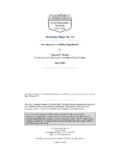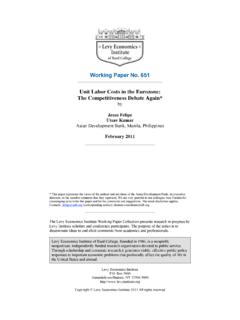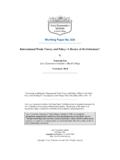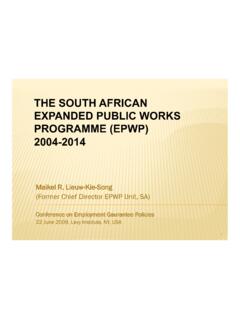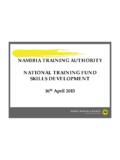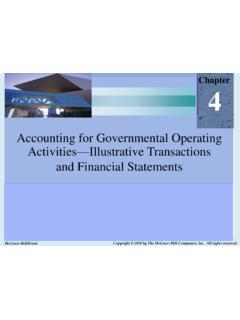Transcription of Working Paper No. 778 - Levy Economics Institute …
1 Working Paper No. 778 Modern Money Theory 101: A Reply to Critics by ric Tymoigne and L. Randall Wray levy Economics Institute of Bard College November 2013 The levy Economics Institute Working Paper Collection presents research in progress by levy Institute scholars and conference participants. The purpose of the series is to disseminate ideas to and elicit comments from academics and professionals. levy Economics Institute of Bard College, founded in 1986, is a nonprofit, nonpartisan, independently funded research organization devoted to public service. Through scholarship and economic research it generates viable, effective public policy responses to important economic problems that profoundly affect the quality of life in the United States and abroad.
2 levy Economics Institute Box 5000 Annandale-on-Hudson, NY 12504-5000 Copyright levy Economics Institute 2013 All rights reserved ISSN 1547-366X 1 ABSTRACT One of the main contributions of Modern Money Theory (MMT) has been to explain why monetarily sovereign governments have a very flexible policy space that is unencumbered by hard financial constraints. Through a detailed analysis of the institutions and practices surrounding the fiscal and monetary operations of the treasury and central bank of many nations, MMT has provided institutional and theoretical insights about the inner workings of economies with monetarily sovereign and nonsovereign governments. MMT has also provided policy insights with respect to financial stability, price stability, and full employment.
3 As one may expect, several authors have been quite critical of MMT. Critiques of MMT can be grouped into five categories: views about the origins of money and the role of taxes in the acceptance of government currency, views about fiscal policy, views about monetary policy, the relevance of MMT conclusions for developing economies, and the validity of the policy recommendations of MMT. This Paper addresses the critiques raised using the circuit approach and national accounting identities, and by progressively adding additional economic sectors. Keywords: Modern Money Theory; Price Stability; Full Employment; Financial Stability; Money JEL Classifications: B5, E10, E11, E12, E31, E42, E58, E6, F41 2 INTRODUCTION One of the main contributions of Modern Money Theory (MMT) has been to explain why monetarily sovereign governments1 have a very flexible policy space that is unencumbered by hard financial constraints.
4 Not only can they issue their own currency2 to meet commitments denominated in their own unit of account, but also any self-imposed constraint on their budgetary operations can be by-passed by changing rules. As such, this type of government is not financially constrained in the way that non-sovereign units are, so that it can focus on issues such as full employment and price stability. Through a detailed analysis of the institutions and practices surrounding the fiscal and monetary operations of the Treasury and central bank of nations like the , Brazil, Canada, Argentina, the Eurozone, and Australia, MMT has provided institutional and theoretical insights about the inner workings monetarily sovereign and non-sovereign governments (Mosler and Forstater 1999; Bell 2000; Bell and Nell 2003; Bell and Wray 2002; Wray 1998, 2003a, 2003b, 2003c, 2007, 2012; Fullwiler 2006, 2009, 2011, 2013; Kelton, Fullwiler and Wray 2012; Mitchell and Mosler 2002; Muysken and Mitchell 2008; Rezende 2009).
5 The institutional insights concern the central role of the Treasury in monetary policy, the way the central bank implements monetary policy, the balance-sheet implications of Treasury and central bank operations, the importance of national accounting identities, and the economic irrelevance of but the political importance of self-imposed financial constraints. The theoretical conclusions of MMT concern the usefulness of combining the Treasury and central bank into a government sector, causalities between desired and actual macroeconomic financial balances, the functional role of taxes and bonds, and the relevant constraints on government. All these institutional and 1 Throughout this article we will restrict our use of the term sovereign government to indicate a government that issues its own currency.
6 As we will discuss, a monetarily sovereign government can choose among alternative exchange rate regimes fixed, managed, and floating which impacts domestic policy space. A government that promises to convert its own currency on demand and at a fixed exchange rate is constrained by its ability to obtain that to which it promises to convert. In that sense, we can say that it is financially constrained even though operationally it cannot run out of its own currency. The problem is that it can be forced to default on its promise to convert (to a foreign currency or to a precious metal). For some purposes, it is useful to separate floating currency regimes from fixed and managed exchange rate regimes. Many of those who adopt MMT make such a distinction, arguing that only floating currency regimes are fully sovereign in the monetary sense.
7 However, many of the principles we outline in this article apply to all currency-issuers but it must be kept in mind that when a government promises to redeem its currency its policy space can be limited. 2 The word currency is used broadly to mean monetary instruments with zero term to maturity ( current ) in physical or non-physical forms denominated in a unit of account and issued by government (treasury or central bank) and private banks. 3 theoretical elements are summarized by saying that monetarily sovereign governments are always solvent, and can afford to buy anything for sale in their domestic unit of account even though they may face inflationary and political MMT has also provided policy insights with respect to financial stability, price stability and full employment.
8 It argues these are important goals that have to be met independently from one another by putting in place structural policies that work independently of the current political climate, and that manage as directly as possible the goal that needs to be achieved. MMT rejects the traditional trade-off between inflation and unemployment, and does not rely on economic growth and fine-tuning to reach full employment. Critiques of MMT can be classified according to five categories: views about origins of money and the role of taxes in the acceptance of government currency, views about fiscal policy, views about monetary policy, the relevance of MMT conclusions for developing economies, and the validity of the policy recommendations of MMT. This article addresses each of these categories using the circuit approach and national accounting identities, and by progressively adding additional economic sectors.
9 The first section focuses on the government sector. The section shows the importance of taxes for the smooth Working of a government-based monetary system, and starts to deal with the consolidation hypothesis. The second section focuses on the domestic private economy and draws some conclusions about the conduct of fiscal policy and the proper stance of the government fiscal balance. The third section adds the central bank and studies the interactions among the central bank, the Treasury and the domestic economy. The fourth section adds the foreign sector and studies the impact on fiscal policy, the role of exchange-rate regimes as well as the level of development of a country. The fifth section focuses on the policy framework and conclusions of MMT. One final point.
10 Many criticize us for presenting nothing new, presuming we believe we have discovered something novel. However, from the beginning, we have always stressed our roots in the work of Knapp, Keynes, and Lerner; we uncovered the significant 1960s work by Minsky on the employer of last resort; we promoted the prescient articles on credit and state money by A. Mitchell Innes; and we credited economists like Goodhart and Vickrey who swam 3 See note 1 for the case of a country that promises to convert its currency on demand. With a fixed exchange rate, access to foreign reserves can act as another constraint. 4 against the mainstream in which both had gained some respect. Mat Forstater plumbed the work of the ancients to find precursors of the taxes drive money throughout the history of economic thought and in economic history.

